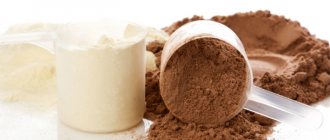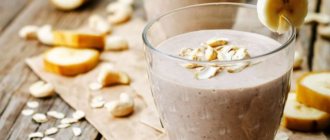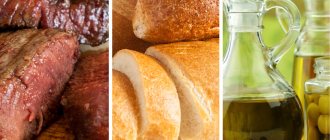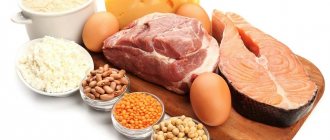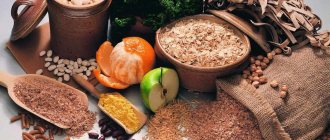Any athlete strives to obtain a maximum of functional mass and a minimum amount of fat deposits. This is difficult to achieve if you eat regular foods. Their calorie to nutrient ratio is poor for effective anabolism. Regular food contains little protein, or it is of plant origin, and therefore has a weak amino acid composition. Gainers with complex carbohydrates will come to your aid.
How do slow carbohydrate gainers work?
A complex carbohydrate gainer also contains pure protein. This combination allows you to accelerate protein synthesis in the athlete’s body three times. If you take all the components of the gainer separately, the effect will be weaker.
Complex carbohydrates take a long time to digest. Their advantage is that they nourish the muscles for several hours, so if you are looking for muscle gainers, this is a good option. In regular food, slow carbohydrates are found in peas, beans, beets, potatoes and various cereals. The carbohydrate content in the gainer can reach 80%. The remaining 20% is taken up by vitamins, proteins and minerals. But there are other proportions where carbohydrates occupy a smaller proportion.
The proteins in the gainer may also vary. Protein is the most important component, so sports nutrition manufacturers try to use only the best raw materials. Among them you can find different types of isolates and concentrates of whey protein, casein protein, as well as milk and egg types of protein.
The gainer also contains other components. This is a complex of vitamins and minerals, the action of which is aimed at speedy restoration of the body. Their presence allows you to maximally protect muscles from the process of catabolism. Therefore, the use of vitamins and minerals is mandatory for any athlete.
Complex carbohydrate gainers allow you to:
- improve sports performance;
- increase definition and gain muscle mass;
- provide the athlete’s body with the necessary amount of energy;
- increase your endurance level.
Can girls drink gainer?
Since gainers (from the English gain - increase, growth) are carbohydrate-protein mixtures designed to quickly replenish energy reserves and increase body weight, you should drink them before and/or after training, when the body needs nutrients most substances. Therefore, timely replenishment is equal to effective recovery, and therefore mass gain.
Thus, if there is no time (opportunity, desire) to eat a full dinner after an evening workout, then you can drink a portion of a gainer, thereby supplying the body with amino acids and glucose. Or drink such a cocktail before training, if there was no time (opportunity, desire) to eat a full lunch, again giving the body glucose so that it has the strength to work in the gym, and amino acids, which are also used for the synthesis of hormones, enzymes and directly new ones muscle cells.
In any case, it should be remembered that gainers are biologically active additives to the basic diet, and therefore cannot replace a complete and balanced diet. Natural food is always preferable.
There are several controversial opinions about how to take gainer. Some argue that the body absorbs the drink better before training, others - after sports.
Professional athletes and coaches, to achieve the best effect, still advise adhering to a strict schedule. You can create a schedule by the hour for when to take the gainer yourself, based on the following data:
- To get an energy boost and increase your caloric intake, drink a smoothie immediately after breakfast.
- Schedule your next appointment an hour before going to the gym to achieve maximum results.
- An hour after an intense workout, when the carbohydrate window opens, you should eat well and drink another portion of the drink.
- It is allowed to replace one meal with a protein shake, but only in situations where it is not possible to eat truly healthy food.
If your exercise in fitness, weightlifting or other sports is far from professional, then it is better not to get carried away with such cocktails before bed, otherwise, instead of a beautiful and toned figure, you can ensure the accumulation of fatty tissue in the most unpleasant places.
This question often worries girls or guys who are tired of the sidelong glances of passers-by and questions from friends about whether they feed you at home? Simply put, to all those whose primary goal is not to gain muscle mass, but simply to gain a little weight.
It is worth noting here that not all professional athletes resort to such nutrition. A gainer without training will help you gain weight, but a significant disadvantage is that the increase will not go to muscles, but to subcutaneous fat.
Read more: Protein for girls
The amount of protein mixture per day is selected strictly individually, based on the athlete’s weight and the number of meals.
Dry mixture is a good source of calories, an excess of which can negatively affect the results of training and lead to disruptions in the functioning of the body.
To correctly calculate the dosage and understand how many grams of gainer you need to drink per day, use the following table.
| Optimal daily intake of dietary supplements from proteins and carbohydrates (grams) | ||||||
| Body weight/nutrition | 50 kg | 60 kg | 70 kg | 80 kg | 90 kg | 100 kg |
| Four meals a day | 81 | 93 | 105 | 117 | 129 | 141 |
| Three meals a day | 91 | 107 | 123 | 139 | 155 | 171 |
| Two meals a day | 100 | 120 | 140 | 160 | 180 | 200 |
The gainer also goes well with creatine.
This mixture allows you to restore the muscular system after intense sports. You can take the gainer after training together with anabolic complexes. For lovers of intense exercise, it will not hurt to provide support to the joints, which are subject to special stress during training. Mixtures containing elements such as collagen, glucosamine sulfate and chondroitin will help restore the musculoskeletal system.
The thin body type is gradually going out of fashion, so many girls strive to gain muscle mass and gain weight, but without obvious manifestations of the fat layer.
However, there are women who, even with a proper and rich diet, cannot increase their body weight. A weight gainer for thin girls will help change the constitution of the body, but subject to the correct dosage and frequent trips to the gym. In this case, during the admission process, you should remember that:
- If protein foods predominate in the diet, then there is no need for additional protein, and its excess will inevitably lead to fat gain.
- It will be necessary to switch to healthy fractional meals, plus the food must be varied and taken frequently: 4-6 times a day. Otherwise, the body simply will not have time to absorb all the beneficial substances from the drink.
- It is worth paying attention to your health. If you suffer from stomach upsets even from eating familiar foods, then it is better to avoid the mixture. A dietary supplement can cause a number of side effects related to the gastrointestinal tract.
https://youtu.be/2kCbHtyc_N4
How to take slow carb gainers
You should take gainers immediately after finishing your workout. This will help quickly restore lost energy and prevent muscle catabolism. Before training, taking the product will help increase its intensity. It is recommended to use the gainer once every twenty-four hours and combine it with pure protein.
A serving containing forty grams of protein and one hundred grams of complex carbohydrates is considered optimal. But in products from different manufacturers this ratio may be different. Preparing the gainer for use is simple. It is mixed with water or milk in a shaker and then taken as food.
Other recipes for making gainer at home[edit | edit code]
How to make a homemade gainer with complex carbohydrates
1 version of a homemade gainer recipe with complex carbohydrates
Ingredients
:
- 100g low-fat cottage cheese
- 100g buckwheat
- 1 glass of milk
- optional: honey, strawberries or other fruits
Bottom line
The prepared gainer contains approximately 80 g of carbohydrates and 30 g of protein.
How to prepare protein and gainer at home?
Option 2 of the homemade gainer recipe
Ingredients
:
- 2 eggs
- 400 ml milk
- 1 teaspoon honey
- optional 1 tablespoon lecithin
How to make gainer at home
Option 3 of the homemade gainer recipe
Ingredients
:
- 200g low-fat cottage cheese
- 2 bananas
- 50 g nuts
- 2 tablespoons honey
- 600 ml milk
Bottom line
The prepared gainer contains approximately 110 g of carbohydrates, 50 g of protein, 20 g of fat, a total volume of 1 liter.
4th version of the homemade gainer recipe
4th version of the homemade gainer recipe
Ingredients
:
- 120g dry oatmeal
- 2 scoops of chocolate protein (62g) (I use ON Whey - it dissolves best)
- 1 banana (170g)
- spoon of peanut butter (32g)
BJU
:
- 1049 calories
- 26g fat
- 130g carbohydrates
- 73g protein
Fill with a small amount of water and throw into a blender. One 600 ml shaker contains a thousand calories, 1/3 of the calories of an athlete’s daily diet.
Rating of the best gainers with complex carbohydrates
Having analyzed reviews of slow-carb gainers, we bring to your attention a review of the best gainers.
- Dymatize Flud 100% Waxy Maize is an excellent set of complex carbohydrates. One of them is dimylopectin. It is obtained from high-density corn starch. The gainer formula allows you to deliver building material for muscles as efficiently as possible. Nutrients enter muscle cells bypassing the destructive effects of the digestive system.
- Dymatize Mega Gainer HI protein - provides the body with complex carbohydrates, protein and accelerates anabolic processes. Restores and improves physical parameters. Gives strength and endurance. Creates good conditions for the growth of hormones that accelerate muscle gain. Gainer with an optimal complex of carbohydrates.
- Optimum Nutrition Pro Complex Gainer - optimal ratio of protein and carbohydrates. High biological activity. The complex is enhanced with twenty-five types of vitamins, minerals and food enzymes. Low sugar content. Only 4%. An excellent tool for increasing muscle mass in a short time.
- Proline MSN Iron Mass is the ideal gainer for quickly increasing muscle mass. Contains a set of egg and whey protein. The composition contains amino acids and an effective complex of carbohydrates. High quality and effective product.
How the gainer works
Translated from English, “gain” means “to gain” or “to acquire.” When applied to a gainer, this term means that it helps to gain strength, muscles, and energy reserves.
Initially, this supplement, one of the first developed for bodybuilders, was made from cheap protein, and its caloric content was given by adding fat and sugar. The quality of such a mixture left much to be desired, and the results did not live up to expectations.
[flat_ab id=”5"]
These supplements are indispensable for those who exercise
- triathlon,
- weightlifting,
- bodybuilding,
- such energy-intensive sports as martial arts, basketball, running, football.
Gainer is primarily indicated for use by ectomorphs - people with a thin physique, as well as those athletes whose body does not have a tendency to quickly accumulate fat reserves. The use of this dietary supplement is one of the best ways to develop both strength and mass for ectomorphs in a fairly short time.
There are many types of gainer. Thanks to this, each athlete will be able to choose a supplement that has an optimal balance of proteins and carbohydrates.
Using a gainer allows you to:
- quickly increase weight for those with a thin build;
- replenish expended energy, maintain a high energy level during prolonged aerobic exercise;
- maintain a stable weight;
- recover as quickly as possible after training.
This mixture is sold in specialized sports stores. If you introduce three servings of the supplement into your regular diet, results will become noticeable within a month. The main thing is not to forget that the effect is achieved by combining the use of the supplement with full-fledged regular training. Increasing the calorie content of the usual menu may be required for athletes whose metabolic rate in the body passes quite quickly.
The name of this dietary supplement comes from the English word “gain” (gain, gain). This type of sports nutrition was developed specifically for thin people who find it difficult to build muscle mass. Gainer is a high-calorie product, a protein-carbohydrate nutritional mixture in which the percentage of carbohydrates prevails over the protein content (from 50 to 80% carbohydrates).
In addition to a powerful charge of energy (one standard portion of a gainer can contain up to 3 thousand kilocalories - these are kilograms of regular food), this supplement contributes to the formation of an optimal glycogen reserve in muscle tissue, better absorption of proteins and amino acids - the “building material” for muscles.
In the old days, in pursuit of calorie content, gainers were “loaded” with glucose, fats and sugar. Currently, on the market you can easily find the best weight gainer for lean weight, with a more balanced composition. Which will help cope with the problem of weight gain and will work as an energy booster and a restorative.
Yes and no. “Yes” - because any gainer is initially a means of increasing body weight, and this product was developed specifically for thin people. “No” - because there are no special “gainers for thin people”. However, there are nuances that you need to pay attention to if things are really bad with weight gain.
It is difficult to imagine anything more comical and absurd than a thin man with thin limbs who has grown a belly. Any of us has seen people like this (most likely, unable to cope with the habit of eating late in the evening and “visiting the refrigerator” at night). This fate awaits anyone who tries to take a gainer while neglecting training.
The gainer will work without working out in the gym, but in this case it will not be muscle mass that will grow, but body fat. And this, of course, is ugly. It's better to stay skinny then! So, without regular workouts, there is no point in drinking a gainer.
Carbohydrates are macronutrients along with proteins and fats. Their peculiarity is that the result of the digestion of carbohydrates is glucose - a source of energy for the body. More precisely, when glucose enters muscle cells, it is deposited there in the form of glycogen, providing energy for muscle work. If your goal is to gain muscle mass, then you first need calories - building muscle begins with providing energy for this process. Carbohydrates are considered the main source of calories.
Carbohydrates are usually divided into complex, or complex,
(oligo- and polysaccharides) and
simple
(mono- and disaccharides). Regardless of the variety, they all pass from the intestines into the blood in the form of glucose. However, in practice molecular classification is not entirely suitable.
More practical is the classification of carbohydrates by glycemic index (GI or GI). According to GI, foods differ in the rate at which carbohydrates (glucose) enter the blood. The higher the GI, the faster carbohydrates are broken down and the faster glucose enters the blood. The faster glucose enters the blood, the higher the concentration of glucose in it. Thus, GI correlates with the level of sugar (glucose) in the blood after eating carbohydrates . The GI scale is built relative to glucose, the rate of increase in blood sugar level of which is taken as 100 (although there is also a scale relative to white bread, so it is important not to get confused here).
The glycemic index is:
Low: from about to 55,
Average: from 56 to 69,
High: 70 and above.
According to the glycemic index, carbohydrates are divided into
slow (low GI)
fast (with medium and high GI)
Typically, simple carbohydrates are fast carbohydrates, and complex carbohydrates are slow carbohydrates. However, there are a number of foods with simple carbohydrates and low GI (eg acacia honey), as well as complex carbohydrates and high GI (eg rice).
The disadvantage of fast carbohydrates is that they stimulate the production of large amounts of insulin, which immediately begins to utilize the glucose obtained from carbohydrates from the blood (and, as a rule, not only excess, but also necessary glucose is utilized, which is why, after a significant intake of fast carbohydrates, time there is a low blood sugar level). As a result, the body will be left without the constant supply of calories so necessary for anabolism. Therefore, slow carbohydrates have a great advantage.
However, immediately after a workout, experts give preference to fast carbohydrates in order to maximize the release of insulin, since its role is limited not only to the utilization of excess glucose in the blood (and after a workout, its level is very low, which means that it is unlikely that anything will be utilized), but and to its entry (as well as amino acids) into muscle cells.
The classification of carbohydrates into fast and slow is also due to the following factor: the rate at which carbohydrates are processed into glucose and released into the blood depends not only on the quality of carbohydrates (simple or complex), but also on the amount of dietary fiber (fiber) in it - a type of polysaccharides that cannot be processed digestive enzymes. The more dietary fiber, the longer it takes for carbohydrates to break down into glucose - regardless of whether they are simple or complex. If, for example, sugar is mixed with fiber, it will break down much more slowly than usual. By and large, this is how we get a slow carbohydrate from a fast one. The optimal proportion for obtaining slow carbohydrates from fast ones by adding fiber is 4:1.
Glycemic index: not so simple
The difficulty with the glycemic index is that it is often relative. The fact is that the same product will have a different GI relative to its culinary processing. For example, durum wheat pasta is initially considered to have a low GI; however, if pasta is overcooked, its GI will become average. Moreover, if this pasta is sweetened during cooking, then regardless of the degree of readiness, sugar will increase the GI of the pasta (like any other carbohydrate product).
The glycemic index can also increase depending on a number of physiological conditions (for example, if the body is deficient in carbohydrates, then any food considered low GI will be absorbed as a high GI food.
Also, the situation can be complicated by mixing in the stomach products consisting of proteins, fast and slow carbohydrates, fats, as a result of which the mixed food will already have its own GI. Moreover, most often the GI increases if carbohydrates are mixed with fats, and decreases if mixed with proteins (in this regard, potatoes with meat will be a healthy dish, unlike the opinion of adherents of separate nutrition; but from a GI point of view, seasoning potatoes with butter is not worth it ).
Don't be afraid of foods with a high GI if they contain few carbohydrates. Oddly enough, carrots have a higher GI than chocolate. However, one carrot contains much less carbohydrates than one chocolate bar.
It should be noted that rice
is a high GI product.
This refers to white milled rice (its GI is high). Therefore, you need to eat at least unpolished rice, and at most brown or black unpolished rice (however, such rice also belongs to the category of fast rice, although its GI will be average). By the way, in this regard, for example, buckwheat has a much greater advantage over rice (both in carbohydrate composition and amino acid composition) and deserves to be considered the number one grain for an athlete. There is a similar difference between oatmeal
, which is cooked in boiling water and does not require cooking (high GI) and whole
oatmeal
(low GI). Since we are talking about cereals, the lowest GI (22) is in barley.
Gainer
– is a high-carbohydrate sports nutrition product;
however, the composition of gainers is different - depending on the presence and ratio of simple fast (glucose, sugar) and complex carbohydrates ( dextrins ). Of course, the best gainer will be one in which complex carbohydrates (dextrins) dominate. However, most often the gainer contains not just dextrins, but maltodextrins, that is, dextrin + maltose + glucose. Maltose is a simple and fast carbohydrate (GI - higher than glucose). Accordingly, the higher the percentage of maltose with glucose and the lower the percentage of dextrin, the higher the GI of maltodextrin. According to some data, the GI of maltodextrins ranges from 30 to 108 (on a scale relative to glucose) .
It is important to understand that gainers with a high glycemic index are recommended to be consumed only after training, when glycogen in the muscles is depleted (only in this case, fast carbohydrates are very useful). Unfortunately, manufacturers do not provide such detailed information about the composition of carbohydrates in gainers. Therefore, at any other time, in order to be on the safe side and avoid side effects, gainers (as well as all fast carbohydrates) should be consumed slowly: it is advisable to stretch the drink portion over 20-30 minutes.
Glycemic load (GL or GL)
In addition to the glycemic index, dietetics uses the term glycemic load (GL) . GL is a measure of the amount of carbohydrates per unit volume of product. The need for this concept is due to the fact that some foods contain carbohydrates with a high GI, but there are so few of them that they are not able to significantly affect blood sugar levels (for example, carrots, watermelon, pineapple, melon, strawberries, apples, pears and etc.). To determine the GL, you need to multiply the GI of the product of interest by the percentage of carbohydrates in it and divide by 100 (for most products, the GL is defined and exists in the form of special tables).
Glycemic load is:
low: 10 and below, medium: 11-19 (inclusive), high: 20 and above.
The higher the GL of a food, the greater the expected increase in blood sugar and the insulinogenic effect of food.
Insulin index: what is it?
If the glycemic index of carbohydrate products indicates the degree of ability to increase glucose levels in the circulatory system, then the insulin index indicates the degree of increase in insulin levels in the blood. It was previously written that the higher the GI of the foods eaten, the more actively insulin is produced, which in this case is designed to lower the elevated blood sugar level. However, there are foods that increase insulin production despite the fact that their GI is low. In addition, insulin secretion is stimulated not only by carbohydrates, but also by protein foods. Insulin itself is produced in response to the intake of any food product in order to transport the resulting nutrients into the body's cells.
Thus, milk, consisting of 4% (fast) carbohydrates (lactose), has a low GI, but its consumption causes insulin to the same extent as white bread. For this reason, it is better to consume milk separately from carbohydrate foods, since there is a high probability that the carbohydrates eaten will be utilized due to a considerable dose of insulin. But drinking milk separately is a good way to increase the level of muscle anabolism due to the release of insulin.
2013 © Bodybuilding for hardgainers



